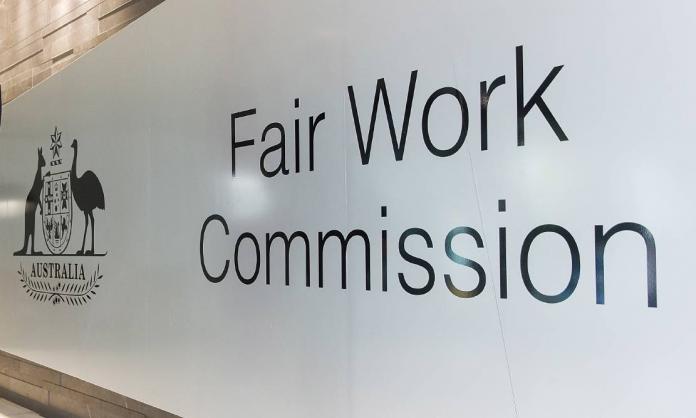There’s plenty to be said about the outcome of the Fair Work Commission’s annual wage review—but the widespread claims of a “union win” fall flat. After all, for most workers affected by this week’s FWC decision, the result will be a cut to real wages.
The Commission increased award wages by 4.6 percent with a minimum increase of $40 per week. For the very lowest paid (including the 184,000 workers on the minimum wage, around 1.6 percent of the workforce), an extra $40 per week represents a pay rise of 5.2 percent. This is barely more than the headline rate of inflation of 5.1 percent in the 12 months to March 2022.
But most of the 1.6 million workers affected by the “Fair Work” decision who are paid slightly above the minimum wage will go backwards. The Commission’s 4.6 percent increase for these workers is not only less than headline inflation—it’s also well short of the 6.6 percent increase in “non-discretionary” prices in the year to March. And it’s way behind the 7 percent inflation figure that the Reserve Bank governor is predicting by year’s end.
Further injury and insult is added by Fair Work delaying the wage increase until November for workers in the hospitality, tourism and airline industries. Workers in retail will have to wait until September, though even on the Fair Work Commission’s own assessment, retail has “fully recovered” from any pandemic slump.
And of course, the decision is light years behind what would be needed to lift all low paid workers out of poverty. The only submission to the Fair Work Commission’s wage review to even address this topic seems to have been from the Australian Catholic Centre for Employment Relations, which pointed out that one commonly accepted definition of poverty sets the “poverty line” at 60 percent of median income. For single income families with one or two children to be above this poverty line would require an increase of more than 40 percent to the national minimum wage.
There’s no mystery about what poverty-level award wages mean for large sections of Australia’s working class. The Australian Services Union has just released results of a member survey in call centres and clerical workplaces, which found that only 7 percent are “living comfortably” on their income, with around half “coping” and 43 percent finding things “difficult” or “very difficult”. Three in ten have foregone health care because they can’t afford it. One in ten have skipped meals, one in ten have pawned goods. Seven out of ten state they have become “worse off” or “much worse off” over the past year. And this is before the full impact of petrol price rises will hit in September, and before the current ruthless and well-coordinated price gouging by the energy companies hits consumers.
Meanwhile, Fair Work figures show that profits have increased by 8 percent per year over the last decade. Australia’s billionaires have doubled their wealth in recent years.
The Commission was never going to address the chronic low wages and obscene inequalities that have been built into huge swathes of Australia’s labour market. If we want to do better, we’ll have to organise and strike for it.
Unfortunately, there’s little sign of this happening on any large scale. A quick look at headline pay increases in enterprise agreements approved on 15 June, the same day as the annual wage review decision was handed down, show a dismal picture: annual increases of 2.5 percent for train drivers in Queensland and concrete truck drivers in NSW; 2.75 percent for port workers in Newcastle; 3 percent for construction workers in Victoria and maintenance workers at a wine maker near Mildura. All these workers—and many millions more—are set to see a sharp fall in their real wages.
One of the few unions to match pay rises to inflation in recent enterprise agreements is the Transport Workers’ Union, which late last year won clauses guaranteeing a wage increase of at least CPI in a series of major enterprise agreements. Though public sector unions in New South Wales have gone on strike against the wage caps of Premier Dom Perrottet, they have mainly been one-day demonstration strikes in support of a political campaign. While welcome, these fall well short of the sort of prolonged industrial action that could create a political crisis for the state government and wreck its wage cap. Similarly draconian wage caps in Victoria have gone largely unchallenged.
The one positive from the misleading hyperventilation about a “union win” regarding the Fair Work wage decision is that it raises the obvious question of why unions would settle for even smaller pay rises. The leaders of the Victorian branch of the Australian Education Union, already under fire after nearly 40 percent of workers voted to reject a new enterprise agreement, is facing renewed pressure from workers disgusted at being sold a 2 percent headline annual pay increase for the next four years.
One sign of what’s possible is the union leadership at one of the country’s largest (and wealthiest) workplaces, Sydney University, voting to pursue a wage claim of CPI plus 2.5 percent. This follows months of agitation within the National Tertiary Education Union, which resulted in the union’s national leaders increasing the pay claim from 12 percent over three and a half years to 15 percent.
Given that this are the same union leaders that, only two years ago, were vigorously pushing a 15 percent wage cut for their members, you wouldn’t want to leave it in their hands to follow through, however. As ever, the only way forward is fighting within our unions to build serious rank-and-file industrial strength, intertwined with a revival in radical politics.
“Who gets what?” is one of the fundamental questions of the class struggle. Soaring profits and billionaire wealth, along with flatlining or falling real wages and conditions, show that it’s well past time for our side to come out swinging. This week’s inadequate “Fair Work” decision underlines that. Any group of workers who organises seriously to strike and win above-inflation pay rises is doing themselves—and the entire working class—a massive favour.









